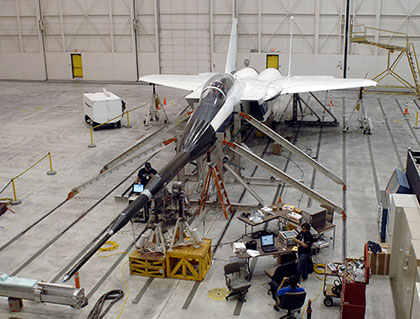The Centre for Process Innovation (CPI) is part of a UK based collaboration that aims to develop novel sensing technologies for the real time monitoring of machined metal parts.
The two year Innovate UK project titled ‘Intelligent Tooling’ is developing embedded sensors and electronic components within high value machining applications in manufacturing sectors including defence, space, rail, automotive, marine and energy.
The collaboration combines world class expertise in machine tooling right across the UK supply chain, bringing together end users and partners to integrate specialist leading research, technology and industrial scale manufacturing. The partners involved are; CPI, BAE Systems, Element Six, The Advanced Manufacturing Research Centre, Advanced Manufacturing Ltd, Printed Electronics Limited, The National Physical Laboratory and DMG Mori Seiki.
The sensing of critical process variables, such as temperature, force, acoustic emission and vibration, applied close to the cutting surface has the potential to create a step change in the capacity and productivity of machining systems. A reduction in cycle times, human intervention and process variation are all achievable through the introduction of embedded sensing.
Small variation in input parameters, such as material and tooling properties, are often only observed in the final inspection of products. Within the high value manufacturing sector, this often leads to conservative parameters or conservative tool lives being enforced. The ability to obtain data on the machining process at the time of cutting, at a lower cost and higher resolution than before allows these small changes to be diagnosed and managed within the processs, leading to better tool utilisation and potential improved processing times.
The Intelligent Tooling project will seek to develop a prototype tooling insert with embedded sensing capability, designed to withstand and exceed the harsh environmental conditions that are present in metal machining. Further developmental focus will be to upscale the prototype to derive the data needed for commercial market adoption.
The embedded sensing technologies developed within the project offer the prospect of ‘right first time’ manufacture on difficult to machine components and alloys. The project has the capacity to deliver increased productivity, capability and tool life, improved capability for product design and performance and reduced operator intervention. Another key aspect of the project is the engagement of industry end users and SMEs who are keen to exploit the machining benefits that printed sensing can provide.
Commenting on the project Mark Wilson, Principal Technologist, Advanced Manufacturing at BAE Systems says:
“Developments like this one are aiming to take machining on to the next level by getting to the heart of the cutting process and then being able to adapt the cutting parameters accordingly – BAE Systems prides itself on being at the forefront of machining technology and this development will keep us at the forefront of its understanding”
Dr Peter Tune, Business Manager at CPI who is leading the project adds:
“CPI’s role in the project is to design and print the electronic sensors, providing expertise in the integration of conventional and printable electronics. Printing will be used where its flexible properties provide great impact. Here it is used to apply sensing functionality close to the cutting edge of the tooling inserts. Conventional electronics will be integrated to drive the sensors and transfer data to the control systems.
Printed sensing is an interesting area as the flexible nature of the technology allows for robust, lightweight sensors to be incorporated into curved structural designs and to be printed in bespoke configurations in high volumes and at low cost. This project represents a tough challenge for printed sensing and the learning will be directly transferrable to other embedded sensor applications where there are similar challenges.”























